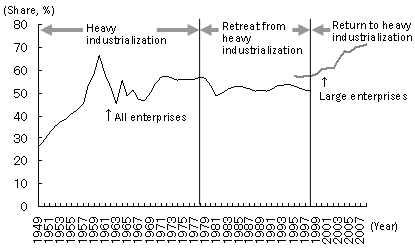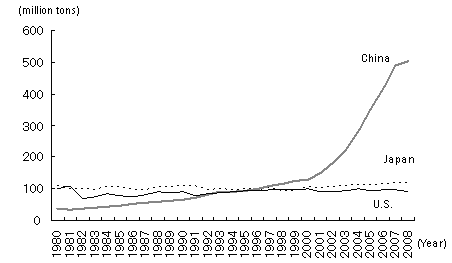Industrialization has accelerated in China on the back of rising inflow of foreign investment since the country started to reform and open up its economy. China has been called the workshop of the world since around 2001, when it became a member of the World Trade Organization (WTO). Since then, the engine of industrial growth has been shifting from light industry, centering on traditional textile manufacturing, to heavy industry. In particular, China now leads the world in the production of steel and automobiles.
A second attempt at heavy industrialization
Since 1949, industrial development in China has gone through a period of heavy industrialization under economic planning, followed by a retreat from heavy industrialization during the early phase of reform and opening up, and finally a return to heavy industrialization starting in the late 1990s ( figure 1 ).
Figure 1: Changes in heavy industry ratio in China

(Note) Heavy industry ratio = heavy industrial production/ total industrial production. Large enterprises denote enterprises with annual sales of more than 5 million yuan.
(Source) Prepared based on data of the National Bureau of Statistics of China
China was still an agrarian nation in the 1950s when it adopted a development strategy that placed top priority on heavy industry in a bid to quickly catch up with developed countries( reference ). However, as a poor country where both capital and savings were scarce, to facilitate the development of heavy industry, which is capital-intensive, the government had no choice but to intervene strongly to concentrate resources on that sector. Specifically, the government artificially kept interest rates, wages, and the prices of energy, raw materials and consumer goods low and allocated them based on centralized plans in lieu of markets, while state-owned enterprises (then called "state-run enterprises") were created to implement those plans. However, the planned economy allowed for no management autonomy, stripping away any incentive for profit-making and innovation. As a result, light industry and the service industry suffered, productivity remained low, and the industrial structure was distorted, Under this system, China was not only unable to achieve its objective of catching up with developed nations, it also suffered a prolonged period of low growth and stagnating living standards. The nation was finally forced to adopt a new development strategy in the second half of the 1970s.
Learning from the failures of the planned economy, starting in 1978, the government embarked on economic reforms at a micro level to provide enterprises with incentives. State-owned enterprises were allowed to retain profits as they enjoyed greater autonomy, and the scope of retained earnings was gradually extended. In the farm sector, meanwhile, communes were being dissolved. As a result, the motivation of managers, workers, and farmers to produce rose, significantly bolstering their productivity. The growth of autonomy has naturally stimulated the development of the market economy, as state-owned enterprises became forced to procure additional raw materials, labor, and capital over the planned volume of inputs and to distribute their output through sales channels in markets exposed to the price mechanism. At the same time, non-state-owned enterprises, including foreign firms as well as township and village enterprises, were encouraged to emerge as players in the market economy. The expansion and deepening of the market economy corrected the industrial structure, which had attached too much importance to heavy industry, and light industry emerged to begin driving industrial development and exports in line with China's comparative advantage.
In recent years, however, heavy industry has developed at a rapid pace, once again becoming a growth engine for the economy. The percentage of industrial production represented by heavy industry (large enterprises) rose from 57.1% in 1998 to 71.1% in 2008 ( figure 1 ).
As seen in the experiences of Europe, the United States, and Japan, which have already achieved industrialization, such a shift to heavy industry is a necessary result of the upgrading of the consumption structure associated with higher income, the expansion of urbanization and infrastructure investment, and the rise in demand for machinery and equipment that accompanies increasing exports of manufactured goods. Heavy industrialization is also an inevitable stage in the development of the Chinese economy, and it has now arrived. Although China has the bitter experience of failed heavy industrialization led by state-owned enterprises under a planned economy in the 1950s, the market mechanism and non-state-owned enterprises, including foreign firms, are playing a significant role this time. Thus heavy industry has turned from being a sector of comparative disadvantage to one of comparative advantage thanks to China's high growth over the past 30 years.
Steel and automobiles as central players
The steel and automobile industries have been driving the development of China's heavy industry in this latest phase of industrialization.
China became the second-largest steel producer in the world in 1993, ahead of the United States and behind only Japan, with crude steel production increasing from just 31.78 million tons in 1978 to 89.56 million tons. In 1996, just three years later, crude steel output in China crossed the 100 million ton mark, making China the world's largest producer. In 2008, crude steel production in China exceeded 500 million tons, accounting for nearly 40% of total world production ( figure 2 ) as the development of China's steel sector accelerated following the nation's accession to the WTO in 2001.
Figure 2: Changes in crude steel production in Japan, the United States, and China

(Source) Prepared based on data from the China Statistics Summary 2009; Comprehensive statistical data and materials on 50 years of new China of the National Bureau of Statistics of China; the Japan Iron and Steel Federation, ad the World Steel Associatio
In addition to the steel industry, the Chinese automotive sector has also achieved explosive development, spurred by the growth in demand associated with higher incomes and the growing presence of foreign manufacturers. Auto production in China, which was only 150,000 units in 1978 before the nation began to open up and reform its economy, topped one million vehicles for the first time in 1992. The industry enjoyed a golden age following China's accession to the WTO in 2001. Auto production rose from 2.33 million units in 2001, and China's global ranking rose from eighth in the world. to fifth in 2002 (passing Canada, South Korea, and Spain), to fourth in 2003 (passing France), and to third in 2006 (passing Germany). In 2008, Chinese production of automobiles reached 9.35 million units, passing production in the United States to move the nation up to second place, behind only Japan. The buoyancy of the Chinese auto market following the global financial crisis of 2008 stands out amid sluggish auto sales in the rest of the world, including Japan and the United States. In 2009, China became the world leader in both auto output and sales, ahead of Japan and the United States.
The shift of the center of industry in China from light to heavy industry will inevitably bring a contraction of production and employment in certain sectors. In fact, as labor-intensive industries face severe challenges with the appreciation of the yuan and the effect of the global financial crisis of 2008, concerns about a possible hollowing out of industry are being expressed within China and overseas. However, seen in the context of the rapid growth of heavy industry, such as the steel and automotive sectors, this dislocation should not be interpreted as a hollowing out of industry but rather as a necessary readjustment in the course of China's industrial upgrading.


